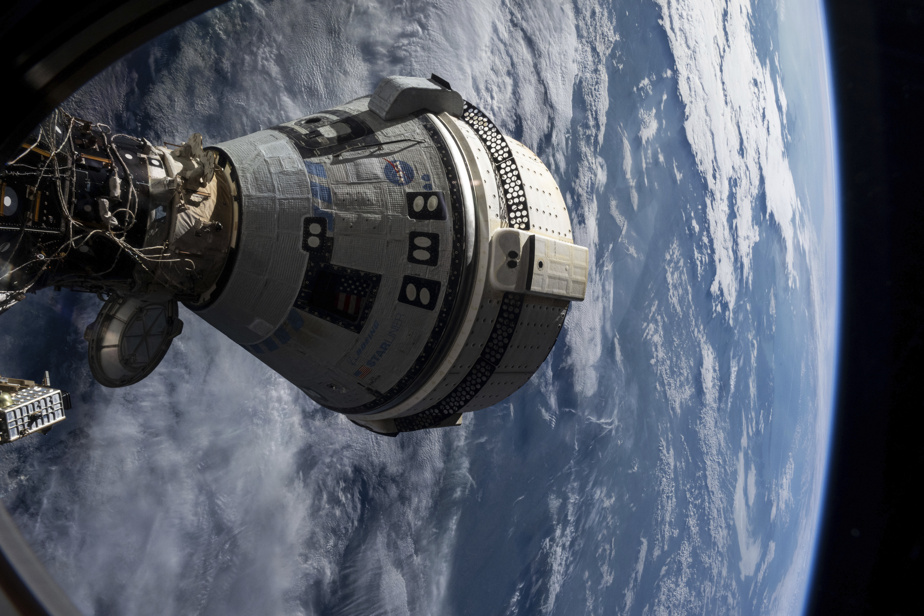For what Starliner Didn’t she come back in June as planned?
Before the launch in June, a helium leak was detected; the launch was postponed. In orbit, other helium leaks were detected. Helium is used to pressurize the fuel.

PHOTO JOE SKIPPER, REUTERS ARCHIVES
The launch of the capsule Starliner in June
Additionally, 5 of the 28 rockets exhibited abnormal behavior once the capsule was in orbit.
These issues required an investigation that turned out to take much longer than expected.
Why wait until the end of August to decide whether the two astronauts would return with Starliner ?
Because NASA wanted to test the origin of the rocket problems. Then there were long discussions with Boeing about the level of risk to astronauts Suni Williams and Butch Wilmore, who took off with Starliner June 5th.
Until mid-summer, Boeing executive Mark Nappi was attending press conferences about Starliner. He always reiterated, with the support of his counterparts at NASA, his conviction that Starliner was safe for a manned return. Its disappearance from press conferences in August was interpreted as a disavowal. Then, on August 24, NASA decreed that Starliner would return empty.
At a press conference Wednesday, NASA addressed the difference of opinion in more detail, citing “tensions” with Boeing.
“Boeing was confident in its model for predicting rocket degradation for the remainder of the mission,” NASA program manager Steve Stich said Wednesday. “The NASA team felt that model had some shortcomings. The question was, could we trust the rockets and confidently predict their degradation between departure from the Space Station and deorbit burn?”

PHOTO TAKEN FROM NASA WEBSITE
The explosion of Challenger in 1986
NASA’s risk assessment was radically different: its top boss Bill Nelson named the two lost space shuttles as the reason for his decision on August 24, Challenger on takeoff in 1986 and Columbia upon landing in 2003.
What tests were done?
Similar rockets were tested at NASA’s White Sands Laboratory in New Mexico to try to reproduce the problem and thus understand it. The rockets Starliner were also fired in orbit while docked with the Space Station.
NASA sent its best rocket scientists to White Sands, who were assigned to half a dozen space missions.
Are Boeing’s problems with its 737s linked to the woes of Starliner ?
Mark Nappi has been asked this question repeatedly. He has consistently maintained that the space division is completely independent of its airliner division, which a federal government report deplored as having an “inadequate safety culture.”

PHOTO ARCHIVES NATIONAL TRANSPORTATION SAFETY COUNCIL, PROVIDED BY THE ASSOCIATED PRESS
The section of a Boeing 737 Max where a door cap fell off during Alaska Airlines Flight 1282.
Richard Aboulafia, CEO of AeroDynamics, a U.S. aerospace management consulting firm, believes that corporate culture problems affect all of Boeing’s divisions. He points out that there have also been problems with the military division, with the KC-46 and MQ-25 tanker programs, the T-7 trainer and attack aircraft and even the VC-25 presidential jet.
“The big boss was not interested in operations and did not want to hear about problems,” Mr. Aboulafia said.
How will Suni Williams and Butch Wilmore return?
With a capsule Crew Dragon SpaceX’s next crew, which was pushed back from August to September, has been reduced from four to two astronauts so that the two astronauts Starliner have room.

PHOTO ARCHIVES NASA, PROVIDED BY AGENCE FRANCE-PRESSE
Astronauts Butch Wilmore and Suni Williams
This is a blow to Boeing, which was competing with the Crew Dragon when NASA awarded the two companies contracts in 2014 worth more than US$7 billion to develop transportation for its astronauts.
After the retirement of the space shuttle in 2011, NASA relied on Russian capsules Soyuz to travel to the International Space Station.
What is the future of Starliner ?
Boeing may well be looking for a way out of the NASA contract, according to Mr. Aboulafia and Todd Harrison, an analyst at the American Enterprise Institute.
“Space is not Boeing’s core business,” Aboulafia said. “They acquired that business by incorporating other companies. And unlike airliners and defense, space is an industry that is being disrupted a lot by SpaceX, which is offering services at a much lower cost.”
Mr Harrison believes that Sierra Space, which is working on the space shuttle Dream Chaser since the beginning of the millennium, is well placed to resume Starliner.
Learn more
-
- 1 billion US
- This is the cost overrun of the Starliner program, assumed by Boeing.
SOURCE : WASHINGTON POST
